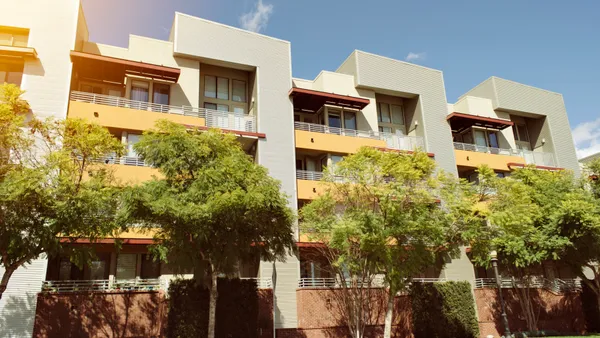Dive Brief:
- The Federal Reserve’s interest rate increases continue to make the lending environment difficult with higher borrowing costs for multifamily borrowers, according to the CBRE Lending Momentum Index.
- Spreads on seven- to 10-year, 55%-to-65%-loan-to-value fixed-rate permanent loans widened four basis points to 176 from the second quarter to the third quarter, marking the second straight quarter of growth.
- Borrowers are having to bring more money to the table. LTVs — the percentage of the loan banks are lending — on permanent fixed-rate multifamily loans closed by CBRE Capital Markets averaged 58.8% in Q3, down 2.9 percentage points from Q2 and 9 percentage points from a year ago.
Dive Insight:
Multifamily agency lending fell 8.4% from Q2 to Q3 — dropping from $33.4 billion to $30.6 billion. Through the third quarter, production volume hit $94.9 billion, above the $93.5 billion volume posted in the same period last year.
Across the commercial real estate spectrum, banks were the top lenders for the second straight quarter, according to CBRE. As collateralized loan obligation lending fell from $12.3 billion in Q2 to $3.39 billion in Q3, alternative lending continued to be constrained. CMBS lending also slowed.
Debt funds, a type of alternative lender, began to fade away from the market over the summer. “Most debt funds are largely out of business for at least another quarter or two because the CLO markets are not receptive,” Max Sharkansky, managing partner at Trion Properties — a multifamily investment sponsor and private equity real estate firm based in West Hollywood, California, and Miami — said earlier this year. “The very large ones are a little more competitive, but not to where they’re competitive with other lenders.”
The pullback of debt funds has impacted LTVs, according to David Fletcher, managing director and head of acquisitions at Excelsa, the Bethesda, Maryland-based U.S. real estate investment arm of Excelsa Holdings.
“With debt funds pulling back, warehouse lines, margin lines and repo lines were closed,” Fletcher told Multifamily Dive earlier this year. “That investor, who was using debt fund capital to get to an 80% LTV in a sub 4% cap rate environment — or sub 3% cap rate in certain cases — cannot secure that financing now.”
As financing options have disappeared, the market has become less competitive for assets, though a high bid-ask spread exists between buyers and sellers, according to Nate Kline, chief investment officer and partner at Stamford, Connecticut-based owner and operator of workforce apartments OneWall.
“In the second half of the year, the market has been less competitive than it was in the first half of the year,” Kline said. “A lot of that has been driven by the rising interest rates and limited debt financing options.”
Click here to sign up to receive multifamily and apartment news like this article in your inbox every weekday.











